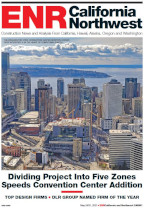Going where they are needed and doing what needs to be done sums up the ethos of Horrocks Engineers since the Utah firm's founding by Gill Horrocks in 1968.
"We have evolved with the needs of the municipalities and our other clients," says Larry Reasch, a Horrocks principal. "Our clients will have a need for something and ask us if we're willing to come in and fill that need. In other cases, we'll see opportunities, and if it makes sense, we'll move to pursue them."
Steady growth, a diverse project portfolio and 2014 revenue of $30.84 million put Horrocks in the No. 2 spot on ENR Mountain States' Top Design Firm ranking for the second year in a row and led the ENR editorial team to name Horrocks the 2015 ENR Mountain States' Intermountain Design Firm of the Year.
The family-owned company launched by Gill, and now led by his son Jim as president, is engaged in the planning and design of transportation, water, sewer and storm drain systems as well as wastewater treatment plants.
Horrocks also performs a wide range of survey and construction management services. The firms' current projects include serving as a consultant to CH2M on the redesign and construction of the landside civil infrastructure for the $1.8-billion Salt Lake City International Airport Terminal Replacement Program.
Horrocks is doing construction management for the $252-million expansion and restructuring of Interstate 15 at the south end of Salt Lake County. In Idaho, Horrocks is working with the Idaho Transportation Dept. (ITD) on a new interchange and railroad bridges on I-84 outside Boise. It is also set to begin work on a design-build interchange near the town of Mesquite for the state of Nevada.
With origins in northern Utah County and currently headquartered in Pleasant Grove, 35 miles south of Salt Lake City, the firm has 285 employees and 10 field offices throughout the Mountain West, with its most recent office openings in Idaho Falls, Las Vegas and Phoenix.
Field Origins
Gill Horrocks was employed by the Soil Conservation Service in the mid-1950s, learning surveying and water management in the field when he joined an uncle living in northern Utah's Brigham City and formed the firm of Todd and Horrocks.
"My father had never finished college, so when Todd eventually retired, Gill went to the University of Utah to get his engineering degree," says Jim Horrocks.
When looking for a location to start his own engineering firm, Jim says his father looked at locations around Utah. "He thought Utah County had growth potential, and he was friends with the mayors of Alpine and American Fork, and they convinced him to stay in this area," says Jim.
Early on, the young company was kept busy with water-resource projects for growing cities and upgrading existing facilities to meet new environmental regulations. "Almost every water treatment plant in the state needed to be upgraded or expanded at that time, and there was a lot of federal money available for water quality projects," says Jim.
The firm designed water resource projects for smaller cities around the state as well as the main water treatment plant for Provo, one of the state's largest municipalities. By the time he joined the firm, Jim says demand for water projects was waning but it was being replaced by a surge in transportation development.
"UDOT (Utah Dept. of Transportation) started to outsource more work, and there was increased funding for transportation, so we started recruiting more employees with a background in that area," he says. "We took on some smaller jobs for UDOT and that eventually led to larger and larger projects."
When UDOT decided to try accelerated bridge construction and replacement on some projects, Horrocks was among the first firms to win bids for projects using the ABC method. "UDOT could see the advantages to accelerated bridge replacement and they made a commitment to using it," Jim says.
Horrocks was the design engineer for the rebuilding of roughly 3.5 miles of I-80 through Salt Lake City to the mouth of Parley's Canyon in 2007-08. It was the first test of the "bridge farm" concept for UDOT, with bridges constructed off site and then moved into place using self-propelled modular transporters. Seven bridges were successfully replaced during the project, thus proving the viability of the method to UDOT and Horrocks. "That was a landmark project for us. It was CM/GC and a high-risk project," Jim says. "But it was successful, and now we look at using accelerated replacement on almost every bridge project we get."







Post a comment to this article
Report Abusive Comment